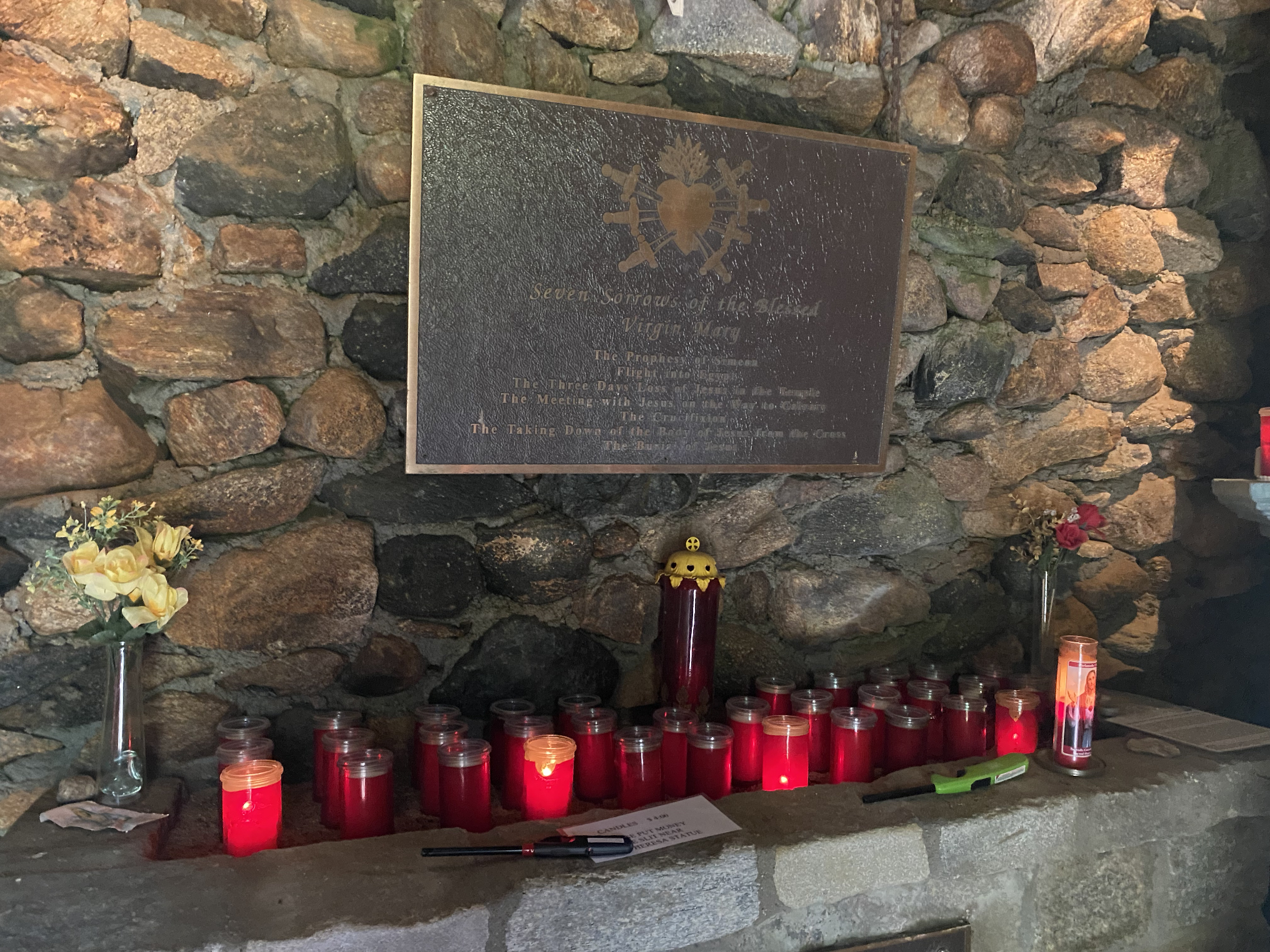BURRILLVILLE – For nearly a century, a vast, unique and quiet property in Nasonville has served as a place of solace and healing for those who make pilgrimage to its grounds.
And with the recent merge of St. Patrick’s Church with a parish already uniting Our Lady of Good Help and St. Theresa, caretakers at the Shrine of the Little Flower are working on improvements to ensure its existence for the next 100 years, under the new banner of, “Burrillville Catholic Collaborative.”
The change became official on Thursday, July 1, with the three churches now sharing a single pastor, while retaining separate buildings and identities. Rev. Michael McMahon, who has served both OLGH and St. Theresa since 2019, was recently appointed by Bishop Joseph Tobin as administrator of St. Patrick in Harrisville, and announced a new schedule of masses and other services at https://burrillvillecatholic.org/.

Church officials are hopeful that the shrine, an important site among the faithful with a rich history, can serve as centralized and uniting center for the community – for both worshipers and non-Catholics alike.
Silvia Aldridge was hired as coordinator for the shrine in May, and for the past three months has been helping to coordinate improvements. She notes that Burrillville’s many Catholic churches were built before the automobile and once had to be within walking distance for parishoners.
“The reality is, we had to come together,” Aldridge told NRI NOW this week, citing the importance of the shrine’s history as the first of its kind in the United States dedicated to St. Theresa, and the only recognized place of pilgrimage in Rhode Island.
“For almost 100 years, it’s been here as this kind of miraculous thing here in Burrillville,” she said.
The story of the shrine – and related St. Therese Church – begin in 1923, when Bishop Aloysius Hickey announced creation of the Nasonville parish, and suggested St. Theresa of Lisieux as the patroness.
Soon after, the newly appointed pastor, Father A.P. Desrochers, was called to the home of a sick woman, visited along with two nuns from Southbridge, Mass., and began a novena for her healing. According to the story, the woman, Florida Faford, had been sick with an illness deemed incurable, but moments later got up from her bed and resumed a normal life.
As news of the miraculous recovery spread, pilgrims began visiting the area, believing it to be a holy place. And Faford herself raised funds to purchase a statue of the saint.
A visit to the shrine of today makes it easy to see how the site has remained a beacon of solace and healing since, for believers for nearly a century.

Situated on a tucked away 8.23 acre parcel off of Douglas Turnpike, the shrine and accompanying church sit on a scenic and peaceful property. Through the years, the serene space has been made more unique through a phenomena Aldridge refers to as, “popular piety,” where individuals decide to create or leave something reflecting their faith of their own accord.
The statute of St. Theresa itself – purchased by worshipers before there was even a church to commission such a task – is a prime example.
“Individuals have always come here and said, ‘I want to do something,'” said Aldridge. “People bring things, clean things, plant things…”
“They’re really important, I think, because they bring people together and create unity, but it’s also personalized,” she said of the acts.
It’s a tradition that continues to this day. From cleaning and lighting votive offerings, to leaving small statues or trinkets and performing grounds work, Aldridge says she has “no idea,” who does much of what takes place on the property. Anonymous visitors have built and donated multiple features over the years, transforming the space into an ever-evolving place for inspiration.
The do-it-yourself acts of worship and volunteerism are encouraged, creating a beautiful and unique place to visit – if a bit of a hodgepodge.
“We’re really open to people doing things like that,” said Aldridge. “The more this is a community enterprise, the better off we are.”
“I come out every day just to see what’s going on,” she said with a wry smile. “I don’t know who’s planting the flowers around Our Lady of Guadalupe.”
The shrine now features dozens of statues donated and brought to the property. Prayers and placards mark a shady grove holding much for visitors to see, with crowns of flowers occasionally showing up on the heads of the saints.

The most prominent feature is the Holy Stairs or Scala Sancta, a replica of the staircase believers say was mounted and descended by Christ on his way to trial during the Passion, which St. Helena later brought to Rome. Originally built with wood, the stairs on the Nasonville land were replaced with field stone, limestone and granite in the 1940s.
A the top is a crucifix, where visitors frequently leave trinkets and mementos as part of their prayers. After time, the offerings are removed by Sister Grace for safe keeping, and Aldridge says she hopes to one day create a memorial with the items.

“It’s probably one of the most fundamental things people have done throughout history,” she said of the act of leaving offerings. “I find it very moving.”
Below the stairs is the Votive Chapel, a dark and quiet space holding the Tomb of Jesus, where visitors are welcome to light candles, or bring their own.
“I think for a lot of people, it’s kind of a place of healing,” Aldridge said.

The surrounding grounds feature the Stations of the Cross, a Rosary Walk and the Garden of the Saints – with many elements built through private enterprise, and maintained and beautified by the same.
A service is held every Sunday at 10:30 a.m. at an outdoor chapel, weather permitting, and a small gift store with religious books and artifacts also welcomes visitors. Benches and picnic tables dot the grounds – and Aldridge notes that anyone is welcome to use them, not just Catholics.

Now, planned improvements are taking place, with a thought-through effort on how features – developed over decades using different methods and materials – can be maintained long into the future, and kept accessible to the community.
“We’d like it to become a sort of cultural and educational resource,” said Aldridge of the shrine, noting plans are in the works for some type of self-guided tour.
Masonry repairs are currently underway at the Holy Stairs, with local Tim Jeremiah donating labor for the project. A damaged fountain was recently put back in working order by local artist Dave LaMontagne, who also donated his time, and soon an asphalt walk will be replaced with a brick-way.

No one knows what materials were used to create one structure erected sometime in the 1970s, but from the way it’s now deteriorating, church officials are guessing it was made with plaster over concrete. The Rosary Walk, another vast and impressive feature built in 1994, is also in disrepair due in part to its location in a wet grove. Aldridge said discussion is now underway on how this element of the shrine will be rebuilt, and possibly relocated to an area with more sunshine.
And each repair it seems, aims to create a balance between what gives the space a feeling that’s both serene and utterly novel, and the functionality that will make it sustainable for the long term.
“We have to move the shrine forward and be custodians of it, while honoring work people have done over time,” Aldridge said. “So many people poured their heart and soul into this place.”
New signage is being added as shrine custodians continue to keep the space open every day from sunrise to sunset, and to welcome parishioners now part of the collaborative.
The space remained open through the pandemic.
“We heard from a lot of people that it was their saving grace,” Aldridge said.
As the parish gets ready for its 100th anniversary and readies for the next century, Aldridge envisions a center for, “devotional, cultural and educational life,” for residents in and out of Burrillville.
“We’ve got to bring people from the outside,” she said, pointing out that the resource is not well-known to many in northern Rhode Island.
To that end, the shrine will launch a speaker series this fall, with the first guest to be Mary Lee Carol, author of “Somewhere Saints.” NRI NOW will publish information about the events as it becomes available.
Aldridge said more volunteer help is always welcome, and, with the size and scope of the ongoing projects, sorely needed. Those who want to learn more or help out can contact the shrine via Facebook.
“We want people in Burrillville to know we’re here, and to come visit us,” said the caretaker. “It’s really not just for Catholics. It’s a place of solace, and a place of peace.”








